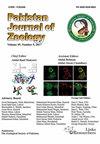Pioglitazone Ameliorates Hypertension Induced Cardiac Hypertrophy and Down Regulates Cardiac Hypoxia Inducible Factor-l α in Rats
IF 0.5
4区 生物学
Q4 ZOOLOGY
引用次数: 0
Abstract
It is known that cardiac hypertrophy induced by hypertension always goes with abnormal myocardial glucolipid metabolism. However, whether or not pioglitazone may alleviate the cardiac hypertrophy and reverse abnormal myocardial glucolipid metabolism is still unknown. We conducted this experiment to explore the influence of pioglitazone on cardiac hypertrophy in rats. Rats with cardiac hypertrophy induced by renovascular hypertension were given a gavage of pioglitazone 5–10 mg/kg for 4 weeks. Our crew determined systolic blood pressure (SBP) and diastolic blood pressure (DBP). Heart mass index (HMI), left ventricular mass index (LVMI), myocardial cell diameter (MCD) and surface area (SA) were further estimated. We members determined FFA and Ang II levels. HE and Masson staining were estimated histopathological changes. The protein and mRNA expression of PPAR-α, CPT-1 as well as PDK-4 were measured by western blot and qRT-PCR. The results showed that pioglitazone could reduced SBP, DBP, MCD, SA, HMI, LVMI as well as myocardial fibrosis and FFA and Ang II levels in serum. Moreover, pioglitazone inhibited the expression of HIF-1α protein and simultaneously enhanced the expressions of PPAR-α, CPT-1 as well as PDK-4 mRNA and proteins. So we infer that pioglitazone could improve hypertension-induced cardiac hypertrophy and redress abnormal myocardial glucolipid metabolism in rats by down-regulating the protein expression of myocardial HIF-1α and increasing the protein expressions of myocardial PPARα, CPT-1 and PDK-4.吡格列酮改善高血压大鼠心肌肥厚及下调心脏缺氧诱导因子- 1 α
高血压引起的心肌肥厚常伴有心肌糖脂代谢异常。然而,吡格列酮是否能减轻心肌肥厚,逆转心肌糖脂代谢异常,目前尚不清楚。本实验旨在探讨吡格列酮对大鼠心肌肥厚的影响。肾血管性高血压致心肌肥大大鼠灌胃吡格列酮5 ~ 10 mg/kg,灌胃4周。我们的组员测量了收缩压(SBP)和舒张压(DBP)。进一步测定心脏质量指数(HMI)、左心室质量指数(LVMI)、心肌细胞直径(MCD)和表面积(SA)。我们成员确定了FFA和angii水平。HE和Masson染色估计组织病理变化。western blot和qRT-PCR检测PPAR-α、CPT-1、PDK-4蛋白和mRNA的表达。结果显示,吡格列酮可降低舒张压、舒张压、MCD、SA、HMI、LVMI,降低心肌纤维化及血清FFA、Ang II水平。吡格列酮抑制HIF-1α蛋白的表达,同时增强PPAR-α、CPT-1和PDK-4 mRNA和蛋白的表达。由此推测,吡格列酮可能通过下调心肌HIF-1α蛋白表达,上调心肌PPARα、CPT-1和PDK-4蛋白表达,改善高血压大鼠心肌肥厚,纠正心肌糖脂代谢异常。
本文章由计算机程序翻译,如有差异,请以英文原文为准。
求助全文
约1分钟内获得全文
求助全文
来源期刊

Pakistan Journal of Zoology
生物-动物学
CiteScore
1.10
自引率
16.70%
发文量
306
审稿时长
4.5 months
期刊介绍:
Pakistan Journal of Zoology (Pakistan J. Zool.) publishes original articles in English on all aspects of animal life. Generally these articles will be in, or related to one of the following subject areas: Physiology, Cell Biology, Molecular Biology, Genetics, Bioinformatics, Toxicology, Forensic Science, Developmental Biology, Entomology, Parasitology, Microbiology, Biotechnology, Pathology, Palaeontology. Taxonomy, Environmental Biology, Wildlife, Fisheries, Vertebrate and Invertebrate Morphology. Additionally, the journal considers research on health and clinical studies. Short communications are regularly considered, however, uninvited review articles, first records/reports of known species, case reports/studies and survey reports are not published in Pakistan Journal of Zoology.
 求助内容:
求助内容: 应助结果提醒方式:
应助结果提醒方式:


